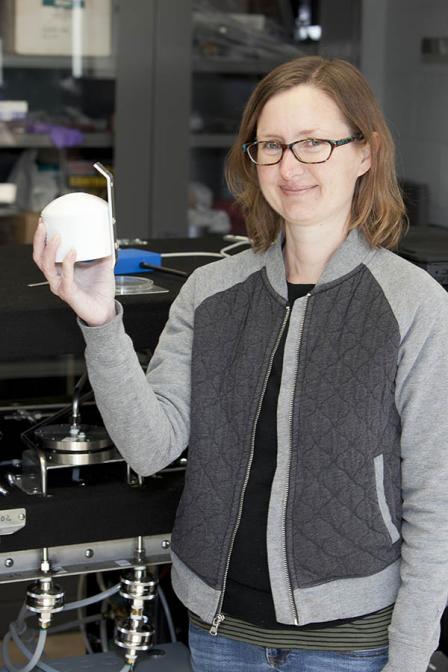Advancing Sensor Technology to Monitor Wildfires
Published April 6, 2018
 EPA researcher Amara Holder holds up one of the sensors that will be tested in the field during wildfires.Sometimes the smallest things can make the biggest difference, even when it comes to measuring air quality. Miniature sensors that can monitor air quality near wildfires are being tapped to protect public health from smoke exposure.
EPA researcher Amara Holder holds up one of the sensors that will be tested in the field during wildfires.Sometimes the smallest things can make the biggest difference, even when it comes to measuring air quality. Miniature sensors that can monitor air quality near wildfires are being tapped to protect public health from smoke exposure.
EPA and other federal agencies and states recognize the need for compact and field-deployable sensor technology to measure air pollutants emitted during wildfires. Rugged but reliable and easy-to-use sensor systems can significantly increase data on air quality conditions during a wildfire or prescribed fire. Data from these small sensors complement measurements obtained from more complex regulatory-grade monitors that are stationary or not easily transported.
EPA and other federal agency partners are responding to the need for more monitoring capabilities during wildland fires through two research projects. One is the Wildland Fire Sensors Challenge that is stimulating innovations in the development of sensors specific for wildfire conditions. The second is a field study to evaluate commercially available sensors during smoke events. These projects build upon EPA’s expertise in developing emissions and ambient monitoring systems that integrate sensor technologies, as well as field evaluation of commercially available sensors under ambient conditions.
Wildland Fire Sensor Challenge
Developers submitted prototype proposals for the Wildland Fire Sensors Challenge in 2017, which is offering a cash prize to one or multiple winners. The ideal monitor will measure fine particulate matter (PM2.5), carbon monoxide (CO), ozone (O3), and carbon dioxide (CO2). The competition requires monitors to be portable and low maintenance, measure a wide range of pollution levels, and report real-time data continuously and wirelessly to a central data-receiving station.
“Our goal for the Challenge is to encourage innovative technology designs that are easy to use and operate as a wireless sensor network and that can be used to assess air quality conditions close to the fire as well as in downwind communities,” says Gayle Hagler, an EPA researcher who is helping to coordinate the Challenge. “The target user is the Air Resource Advisor who is responsible for developing public health communications about air quality conditions and could benefit from expanded air monitoring technology options.”
The Challenge received 27 submissions, ten of which have been selected for further testing by EPA and the U.S. Forest Service (USFS). The first phase of testing is being conducted by EPA under controlled laboratory conditions. The second phase will be conducted by the USFS in its Missoula Fire Sciences Laboratory. The results of the Challenge are expected to be announced this year.
In addition to the USFS, EPA is conducting the Challenge in partnership with the National Oceanic and Atmospheric Administration (NOAA), National Aeronautics and Space Administration (NASA), and the Centers for Disease Control and Prevention (CDC).
Sensor Testing in the Field During Wildfires
In another project, EPA researchers are collaborating with the USFS and other partners to evaluate the performance of fine particle pollution (PM2.5) sensors already available commercially for their ability to operate under real-world wildfire conditions. EPA researchers are putting the sensors into portable units, evaluating their performance in the lab, and testing them in the field during the 2018 wildfire season.
“The goal is to identify emerging air sensor technology that can enhance efforts to monitor air quality during a wildfire event and to provide guidelines for communities and government agencies on the use of these sensors,” says Amara Holder, EPA researcher and principal investigator.
The sensor packages will be designed to operate for up to a two-week period with minimal maintenance and without access to power. Following the study, a performance evaluation report will be developed that can be used by states, tribes, communities, and public health officials to learn more about the potential application of sensors for wildfire smoke monitoring.
Learn More
Wildland Fire Research to Protect Health and the Environment
